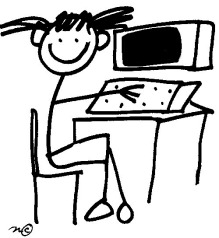I had an epiphany recently that vastly improved my approach to writing and blogging. I’d somehow fallen under the notion that the only way I knew of to generate writing/blogging ideas was to free-write (write without stopping or editing) until the answers came. And, yes, that kind of worked, but I was getting frustrated with having to write so many blind pages. Free writing didn’t always seem that efficient.
The best solution is usually the simplest one. There are TONS of brainstorming techniques other than free writing. I knew this but wasn’t using them. Using a variety of brainstorming techniques mixes up the brainstorming process, makes it fun and interesting, and maybe even saves time.
Maybe you’re working on an outline but have a plot hole you’re struggling with, or you’re planning a blog post that’s missing key ideas. Try some of these brainstorming techniques to fill in the gaps. You probably already know this, but when brainstorming remember to never censor yourself. The BEST ideas come right after the most outlandish ones. Good luck! –Eve Messenger
BRAINSTORMING TECHNIQUES FOR WRITERS & BLOGGERS by Eve Messenger
ROLE PLAY

1. Perspective Shift
Approach your brainstorming topic as if you were in a different place or time, or even as if you were a different person. What if you were in your favorite hiding spot as a kid? What if you were on Mars, in the middle of an ancient forest, in a great library, or sitting at a Paris cafe with Lost Generation writers? What might your approach be if you were your favorite writer? What if you were the best you living life in your dream situation?
2. Attribute Change
This is like Perspective Shift, except you’re only imagining changing one aspect of yourself. Approach your brainstorming topic as if one attribute about you is different: gender, race, socioeconomic status, religion, ethnicity, nationality, profession, etc.
3. Super Power
Imagine you have a super power that lets you get right to the root of your answer. Explore your topic from that super power perspective. If your topic feels murky, imagine you’re Aqua-man (or Aqua-woman), who can see clearly beneath the water and swims quickly and powerfully toward the solution.
BE A REBEL

4. The Opposite Approach
It’s remarkable what good ideas can be sparked by exploring bad ones. Deliberately try to cause problems for your topic. Now write down those problems and see what solutions come.
5. The Five Whys
In this brainstorming technique, you get to be the little kid who asks “why” ad nauseam. Starting with your brainstorming topic/problem, ask why at least five times: “Why is this happening?” Answer. “Why is that happening?” Answer. And so on.
MIX IT UP

6. Z to A
Write whatever comes to mind starting with each letter of the alphabet, Z to A. For example, let’s say you’ve got a lot of half-ideas floating around in your head and you want to solidify which you should write on. First, solidify your question: “What should I write about in my next blog entry?” Then open up the floodgates to your subconscious and let the ideas flow. Each idea you write must begin with the next successive letter of the alphabet. The trick in brainstorming is to not beat yourself up about bad ideas. In this brainstorming technique, you’ll come up with 26 ideas. Pick the three best ones.
Zoo animals in YA fiction.
Young people are frustrated by not being properly represented in YA fiction.
X-ray closely the dark underbelly of publicity for YA books.
and so on until you reach “A”. . .
7. Cubing – D/C/A/A/A/A
Approach your brainstorming topic from six different angles:
- Describe
- Compare
- Associate (what does your topic make you think of?)
- Analyze (what is your topic composed of?)
- Apply it (how can your topic be used?)
- Argue for or against your topic
8. List
This brainstorming technique is simple and straightforward. Just make a list of the story/passage/character ideas and elements you want to convey.
9. Fill in the Gap
You probably already have some solid ideas for your novel or blog post, but now you’re looking to fill in the gap. Make connections from your solid ideas to the one that’s still missing. Build the bridge. Fill in the hole.
10. Commonalities
Parallel your topic with other similar topics. What does your topic have in common with what other writers have written? List the commonalities and apply them to the topic you’re brainstorming.
11. Sentence Starters
Give yourself sentence starters.
“What if ___________.”
“The way this will work is if ______________.”
“The best solution to this problem is ________________.”
HAVE FUN WITH SCHOOL SUPPLIES

12. Mind Mapping
This brainstorming technique is probably the one many of us learned about in school. Get a big piece of paper or a dry erase board, In the center, write your brainstorming topic. Without censoring yourself, write down all ideas related to that topic–the sillier and more outlandish the better. After exhausting all ideas, start connecting them and branching other ideas off of them.
13. Starburst
Draw a large six-pointed star. At the tip of each point write: who, what, when, where, how, and why. In the middle write your topic/goal/problem. Now answer each of your “tip” questions.
14. Index Cards
Get a stack of ten or so index cards. On each one, jot down a key image or idea from your brainstorming topic. Now shuffle the cards, pull out one at a time, read your idea/image, and brainstorm responses.






